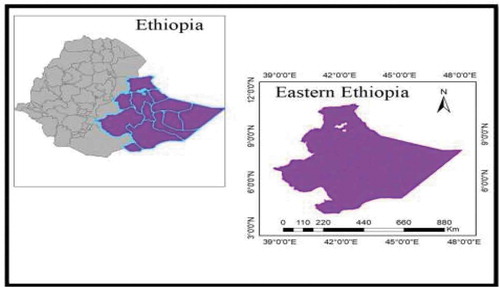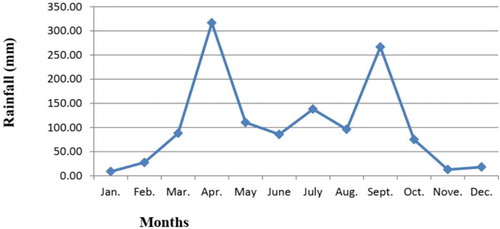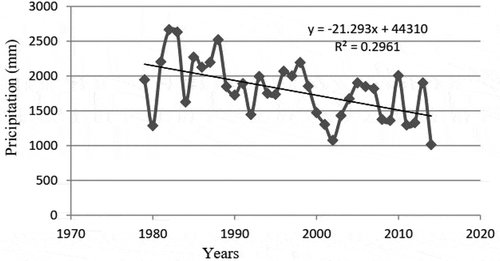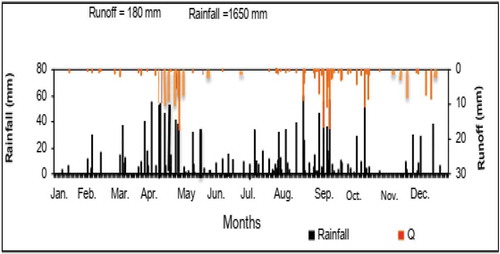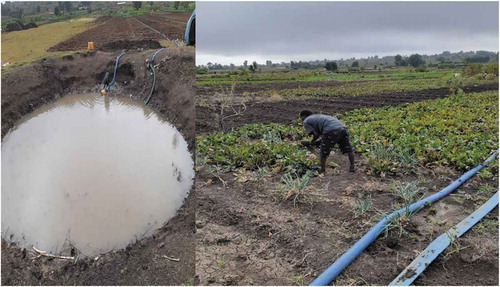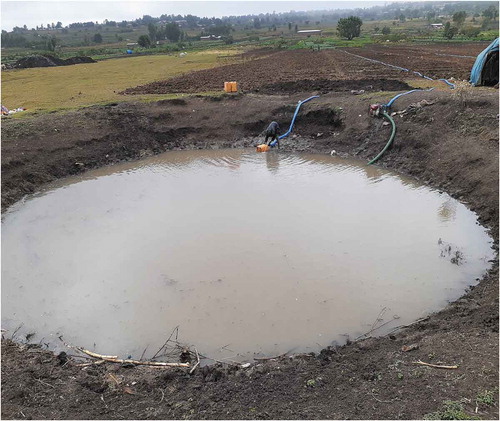Abstract
Rainwater harvesting has been known and widely practiced for many centuries, especially during the dry season for a different purpose. The increase of agricultural economy of the country is extremely exposed to weather and climate effects. Decrease of crop production in dry areas is linked to the water (runoff, evaporation and overindulgence use). The objective of this manuscript is to review the status of rainwater harvesting (RWH) technology and practices in sustaining agricultural production in Ethiopia. The in-situ and ex-situ RWH techniques have shown a significant impact on improved soil moisture, runoff and ground water recharge and increased agricultural production, which, in turn, reduce risks and deliver positive impacts on other ecosystems. The implementation of thousands of indicated above structures has been also confined with a range of problems and challenges. In the eastern part of Ethiopia, water shortage and lack of improved technology were the main problems, therefore practicing water harvesting and supplying improved water harvesting technologies providing extended service regularly for farmers should be practiced in the future. Therefore, from the point of view of water conservation, both internal and external catchment-based RWH had the eminent potential of mitigating rainfall-related crop production risks.
PUBLIC INTEREST STATEMENT
In the coming decade, climate variability and change of rainfall from year to year become the serious issues. Researchers found that water harvesting practice during rainy season and use during dry season for Irrigation can increase production and productivity and can adopt the challenge of climate variability. Rainwater harvesting system to reduce climate change variability has two goals: first, to be one of the alternatives for clean water source during a drought, and second, provide adaptation actions to reduce flooding. In Ethiopia, water shortage and lack of improved technology were the main problems, therefore practicing water harvesting and supplying improved water harvesting technologies providing extended service regularly for farmers should be practiced in the future.
Competing Interests
The authors declare no competing interests.
1. Introduction
Agriculture in Ethiopia is the fundamental of the country’s economy, in which half of the gross domestic product (GDP) and 84% of export with 80% of total 110 million populations are engaged in this sector. According to Conway and Schipper (Citation2011), the dependency of farming system on rain-fed agriculture has made the Ethiopia’s agricultural economy extremely exposed to weather and climate effects. The failure of rain and the occurrence of drought or consecutive dry periods during the growing season lead to crop with dramatic economic consequences.
Improving rainwater harvesting (RWH) can improve agricultural production by making water available during the time of dry periods. RWH is the deliberate collection of rainwater from a surface known as catchment and its storage in physical structures or within the soil profile (Mati et al., Citation2006). The RWH techniques most commonly practiced in Ethiopia are runoff irrigation (runoff farming), flood spreading (spate irrigation), in-situ water harvesting (ridges, micro basins, etc.) and roof water harvesting.
In Eastern Ethiopia, the small farmers depend on rainy season where rainfall is from March to May and June to September, and much of the valuable water is soon lost as surface runoff. While irrigation may be the most obvious response to drought, it has proved costly and can only benefit a privileged few. There is now increasing interest in the low-cost alternative—generally referred to as “RainWater Harvesting” (RWH). Ethiopia is strongly influenced by climatic and hydrological variabilities that are reflected as dry spells, droughts, and floods. Droughts and floods are becoming common, with significant events every 3–5 years, with increasing frequency compared to two or three decades ago. Droughts destroy watersheds, farm lands, and pastures, contributing to land degradation and causing crops to fail and livestock to perish (Awulachew et al., Citation2005).
To increase agricultural production and living standard in dry lands of Ethiopia, greater priority must be given to enhancing efficiency of water collection and utilization. Since quantity and availability of rainwater in a given time in a given area is the prime factor that largely determines the performance of rain-fed agriculture, its improved efficiency can substantially augment the country's food security achieving endeavors (Awulachew et al., Citation2005). Water harvesting technologies have been quite helpful in rehabilitating degraded hillsides in Harar where the advantage of this rather is twofold: the first advantage is conserving water for seedling establishment in the upstream area, while the other is protecting the down streams from flood damage.
Water harvesting technology serves as a base for the formulation of irrigation projects. Therefore, an assessment could assist in identifying constraints for future strategies that address water scarcity and consequently food security issues at household and national levels. The objective of this study is to review the status of RWH technology practices and implication of climate change on agricultural production in Eastern Ethiopia.
2. The history of water harvesting in Ethiopia
In Ethiopia, there is evidence that ancient churches, monasteries and castles used to collect rainwater from roof tops, and the history of RWH by the Aksumite Kingdom dates back as early as 560 BC (Mitiku, Eyasu, & Girmay, Citation2001). During this period, rainwater was harvested and stored in ponds for agricultural and domestic water supply purposes. Moreover, remains of water harvesting setups still exist in the oldest places of Axum, Gonder, and Lalibela, which were used for different productive and religious rituals. Nowadays, rainwater was harvested and stored in ponds for agriculture and domestic use (Seyoum, Citation2003). Despite its long history, only a few decades ago water harvest has received renewed attention from policymakers. According to promotion and application of water harvest techniques, addressing water scarcity began through the government-initiated soil and water conservation programs as a response to the 1971–1974 drought in Tigray, Wollo and Hararghe (Seyoum, Citation2003). However, the intervention was limited because of the low level of community participation and the declining attention by the government. After the fall of Derg, Federal Democratic Republic of Ethiopia established in 1995 adopted the Agricultural Development Led Industrialization (ADLI) strategy, which emphasizes improvement in agricultural productivity to achieve food security and sustainable development (Desta, Citation2004). The Ministry of Agricultural development and respective regional Bureaus planned and implemented aggressive and ambitious water harvesting programs along with the country’s food security programs (Desta, Citation2006). Based on this, many different water harvesting technologies have been developed by regional states, NGOs, communities and individual farmers throughout the country. Surface irrigation, including river diversions development and pond system, is widely used in Tigray to irrigate plots. In the highlands of Tigray, farmers construct ponds for the storage of spring water to irrigate their farms (Mitiku et al., Citation2001). Diversions' structures are made simply of stones and wood. The floods frequently wash them away. The canals are not lined, and water loss through seepage is significant.
The objective is that the adoption of water harvesting technologies, households would be food self- sufficient and the surplus would be generating income. In addition, incomes have been generated through sale of water. In Kobo Ethiopia, the outputs from flood diversion (spate irrigation) are giving confidence to the farming community. Traditional flood harvesting systems in Kobo are that the technique is fully managed by the farmers who know how to implementthemselves with their own resources (Nigigi & Stephen, Citation2003; Tesfaye, Citation2003). Similarly, the people in Konso, Gidole and many other parts of Wolayta and Wollo, the southern part region, have been exercising the art of conserving soil and water (Tesfaye, Citation2003).
3. Location of Eastern Ethiopia
Eastern Ethiopia (Figure ) is characterized by plateaus, rugged mountains, deep gorges, and flat plains. The altitude ranges from 450 to 3,400 m above sea level. The three agro-ecological zones, dega (highlands—elevations above 2,300 m), woina dega (midlands—+ elevations between 1,500 and 2,300 m.a.s.l), and kolla (lowlands—below 1,500 m.a.s.l) are visible.
3.1. Eastern Ethiopia climate characteristics
In the eastern part of the country, the impacts of climate change are severe on agriculture. Agriculture (including animals), which is central to livelihoods in Africa, is considerably vulnerable to Credit Valley Conservation (Gebreyes, Zinyengere, Theodory, & Speranza, Citation2017). Rainfall variability is a recurring and worldwide phenomenon having spatial and temporal characteristics that vary significantly from one region to another. Hence, it is important to note that the most severe human consequences of rainfall variability are often found in arid or semi-arid regions of the eastern part of the country where water availability is already low under normal conditions (aridity). Throughout the year and decade, rainfall fluctuation and variability is often one of the most shocking weather phenomena and greatest challenges which have a negative effect on the human population (Figures and ).
3.2. Computed from data obtained from NMA (1979–2014)
The dry rainfall anomaly showed that 50% of the observed seasons experienced an amount of rain lower than the long-term mean with 50% of positive anomaly. Osman and Sauerborn (Citation2001) also found that negative anomalies with dry rainfall have frequently been lower than the long-term average of the eastern part of Ethiopia. Based on Ayalew, Tesfaye, Mamo, Yitaferu, and Bayu (Citation2012) drought classification, 10 droughts occurred in dry rainy season in which 4 of them were extreme droughts (SRA < −1.65) and 6 were moderate droughts (−1.28 < SRA < −0.84). According to Ayalew et al. (Citation2012) Standardized Rainfall Anomalies classification, five droughts occurred during rainfall season during the study period, that is two extreme droughts (SRA < −1.65), one severe drought (−1.65 < SRA < −1.28), two moderate droughts (−1.28 < SRA < −0.84) (Figures and ). Moreover, the frequency of drought as well as negative anomaly during rainy season has increased in the last decade. Generally, this study indicates that rainfall in the study area has shown inter-annual variability while rainy season showed more inter-seasonal fluctuations than dry season implying its unsuitability for the rain-fed type of crop production, especially for long maturing crops.
3.3. Rainfall and runoff estimated by modified soil moisture balance method
Runoff is the movement of water which is from rainfall, across the earth’s surface towards stream channels and water stored in harvesting area (Figure ). The characteristics that affect the rate of runoff include rainfall duration and intensity as well as the ground’s slope, soil type and ground cover. Recharge contribution to the wells of shallow depth was prominent than the deep wells. It shows that the recharge from these structures contributes to the shallow wells effectively. But it may take long time to contribute to the deeper wells. It is also evident that it is important to collect runoff water in structures such as runoff collection tanks to maintain the water levels in the wells high.
The science of the graph in Figure is showing discharge versus time. At the beginning, there is only base flow gradually depleting in an exponential form. After the storm commences, the initial losses like interception and infiltration are met and then the surface flow begins (Figure ). The hydrograph gradually rises and reaches its peak value after a time tp (called lag time or basin lag) measured from the centroid of the hyetograph of net rain. Thereafter, it declines and there is a change of slope at the inflection point, i.e. there has been an inflow of the rain up to this point, and after this, there is a gradual withdrawal of catchment storage (Raghunath, Citation2006).
Figure 6. Rainfall, discharge and infiltration characterization (Raghunath, Citation2006)
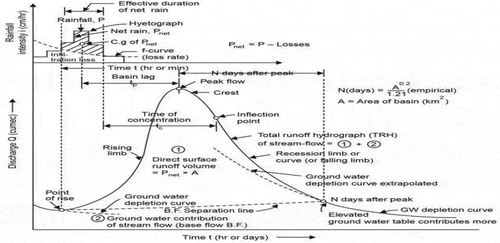
4. Classification of rainwater harvesting techniques
RWH systems for crop production are divided into three different categories, basically determined by the distance between catchment area (CA) and cropped basin (CB) (utilization area): In-situ RWH, internal (Micro) catchment RWH and External (Macro) catchment RWH (Hatibu & Mahoo, Citation1999).
5. In-situ rainwater harvesting
The first step in any RWH system involves methods to increase the amount of water stored in the soil profile by trapping or holding the rain where it falls. This may involve small movements of rainwater as surface runoff in order to concentrate the water where it is wanted most. In-situ RWH is sometimes called water conservation and is basically the prevention of net runoff from a given cropped area by holding rainwater and prolonging the time for infiltration. This system works better where the soil water-holding capacity is large enough and the rainfall is equal or more than the crop water requirement, but moisture amount in the soil is restricted by the amount of infiltration and/or deep percolation (Hatibu & Mahoo, Citation1999).
Essentially, it includes all conventional approaches to soil and water conservation designed to enhance rainwater infiltration. Examples of in-situ RWH techniques include deep tillage, dry seeding, mixed cropping, ridges and borders, terraces (“fanya juu” and “fanya chini”) and trash lines (Mbilinyi, Tumbo, Mahoo, Senkondo, & Hatibu, Citation2005), vegetative/stone contour barriers, contour trenching, contour farming and tie ridging methods (Sivanappan, Citation2006).
In-situ rainwater conservation technologies are distinct from runoff farming systems in that they do not include a runoff generation area, instead it aims at conserving the rain where it falls in the cropped area or pasture (Alem, Citation1999). The most commonly implemented technology is conservation tillage which aims to maximize the amount of soil moisture within the root zone. A number of cultural moisture conservation practices such as mulching, ridging, addition of manure, etc., could fall under this category. In-situ rainwater conservation technology is one of the simplest and cheapest and can be practiced in almost all the land-use systems. In-situ water conservation systems are by far the most common (Figure & Rockström, Citation2000) and are based on indigenous/traditional systems (Reij, Scoones, & Toulin, Citation1996). The primary objective has been to control soil erosion and, hence, manage the negative side effects of runoff soil and water conservation measures, in order to ensure minimal runoff. The in-situ RWH techniques, due to the improved soil moisture storage, significantly affected grain yield of the maize (Milkias, Tadesse, & Zeleke, Citation2018)
Figure 7. The effect of in-situ rainwater harvesting treatments on grain yield (kg/ha) of maize grown with different in-situ rainwater harvest treatments between 2015 and 2017 crop seasons (Milkias et al., Citation2018)

6. External (Macro) catchment rainwater harvesting
This is a system that involves the collection of runoff from large areas which are at an appreciable distance from where it is being used. In Eastern Ethiopia, during rainfall is become erratic one of the alternative moisture conservation strategies to mitigate drought effects is full irrigation and supplementary irrigation (Figure ). In this type of water harvesting, runoff from large areas is collected and taken to farm land. This type of RWH has characterized runoff and channelized flow of the catchment rainfall (Hatibu & Mahoo, Citation1999).
7. Evaluation of RWH in Eastern Ethiopia
According to the progressive evaluation report on the implementation of RWH in Eastern Ethiopia (Chala et al., Citation2003), 98% of sampled beneficiaries responded high seepage. The amount of collected water was not sufficient to meet the intended purpose according to 53% of the farmers in Eastern Ethiopia. All the beneficiaries indicated that the catchment for collecting runoff was sufficient but not the size of the RWH structure. The report concluded that the status of the constructed ponds was not good owing to various problems like the unavailability of plastic sheet to reduce seepage losses, lack of coordination and facilitation during implementation, while community and land holding size were not taken into account during the design and implementation.
The RWH structures in drought areas of Oromia, Somali and Afar face many problems, many of which originate from the speed and scale of implementation (Rämi, Citation2003). Among the identified problems were:
Poor site selection: it was done hurriedly and without experience, with the consequence that many tanks do not hold water. Often the level of poverty was used as the most important criterion for selection of target beneficiaries, while the technical criteria of runoff and water-collecting potential were neglected. Poor site selection is the most important reason for failures.
Leakage: Most of the tanks (cemented) were leaking due to cracks in the walls of the structures. This was attributed to the lack of skilled labour during construction and the poor quality of work as a result of the quota system imposed by the regional government that puts junior experts and development agents under pressure to construct tanks quickly.
Siltation
Wastage and uneconomical use of water.
In the semi-arid areas of Ethiopia, tied ridging as in-situ water harvesting has been found to be very efficient in storing rainwater particularly in drier seasons and leads to substantial increase of yields in some of the major dry land crops including maize, sorghum wheat and mung bean regardless the different planting patterns used, i.e. planting in the furrow or on top of the ridge compared to the flat seed bed.
Milkias et al. (Citation2018) also concluded that the most efficient and cheapest way of conserving water is in-situ RWH. Evaporation losses can be reduced greatly if rainfall is stored in the soil rather than in an open structure. Gebre and Giorgis (Citation1980) and Bayu and Alemu (Citation1998) further concluded that in-situ RWH practices are also more economically feasible to resource-poor farmers than ex-situ RWH methods.
Different studies in Ethiopia showed the potential of different in-situ RWH methods to enhance soil moisture storage and rainfall use. Milkias et al. (Citation2018) studied different in situ RWH methods on soil water storage and on the growth, grain yield and water-use efficiency of sorghum in the Central Rift Valley and he concluded that soil moisture increased compared to conventional tillage methods. Temesgen (Citation2007) showed that tied ridging performed better in retaining water than the local tillage practice (with Maresha plow) and inverted broad beds (with broad bed maker) providing more water to crop production in a semi-arid region where rainfall is erratic.
8. Conclusion
In the eastern part of Ethiopia, water scarcity is the main problem, and using of water harvesting is experienced. Many of research found study about contribution of the effective use of water harvest in the coming climate change, which is the only solution to adopt serious change of climate. To alleviate drought, RWH technologies are proposed by the government of Ethiopia as a practical and effective alternative to improve the livelihoods at little cost and with minimal outside inputs. RWH, which is a deliberate collection of rainwater, can improve agricultural production by making water available during the time of dry spells. Nowadays, the government of Ethiopia proposed RWH technologies at the village or household level to improve the livelihoods of rural and urban people at little cost and with minimal outside inputs. RWH is one option to use runoff better by capturing and storing when rainfall is abundant for periods when water is scarce.
Additional information
Funding
Notes on contributors

Tasisa Temesge Tolossa
Tasisa Temesgen is Lecturer, Researcher, Reviewer and Coordinator for Natural Resources Management program, Haramaya University. He is specialized in Irrigation Agronomy from Haramaya University. His research interest is on Irrigation management and soil conservation.
Firew Bekele Abebe
Firew Bekele is Lecturer and Researcher in school of Natural Resource Management and Environmental Science. He is specialized in Plant Biology and Biodiversity from Addis Ababa University. He is reviewer for international and local journals.
Anteneh Abebe Girma
Anteneh Abebe is Lecturer and Researcher in Environmental Science program. He is specialized in Environmental Science and Management from Haramaya University. He is actively participating as Scientific Researcher in Woody Weeds Project.
References
- Alem, G. (1999). Rainwater harvesting in Ethiopia: An overview. In Integrated development for water supply and sanitation (pp. 387- 390). 5th WEDC Conference, Addis Ababa, Ethiopia.
- Awulachew, S. B., Mey, D., Kamara, A., van Koppen, B., Penning de, V., & Frits, B. E. (2005). Experiences and opportunities for promoting small-scale/micro irrigation and rainwater harvesting for food security in Ethiopia (IWMI Working Paper 098). Colombo, Sri Lanka: International Water Management Institute (IWMI). pp. x, 86.
- Ayalew, D., Tesfaye, K., Mamo, G., Yitaferu, B., & Bayu, W. (2012). Variability of rainfall and its current trend in Amhara region. African Journal of Agricultural Research, 7(10), 1475–11. doi:10.5897/AJAR11.698
- Bayu, W., & Alemu, G. (1998). Soil management and crop technologies for improved crop production in marginal rainfall areas of Wello. In B. Seboka & A. Deressa (Eds.), Agricultural research and technology transfer attempts and achievements in Northern Ethiopia. Bahir Dar, Ethiopia.
- Chala, A., Etissa, E., Lemecha, G., Hunde, H., Desta, L., Jateno, W., & Ayele, W. (2003). Progressive evaluation on water harvesting schemes implementation in Oromia Region (part I). Rural and Agricultural Development supreme Office, 151, 673–678. Berlin: Blackwell Verlag.
- Conway, D., & Schipper, E. L. F. (2011). Adaptation to climate change in Africa: Challenges and opportunities identified from Ethiopia. Global Environmental Change, 21(1), 227–237. doi:10.1016/j.gloenvcha.2010.07.013
- Desta, L. (2004). Concepts of rainwater harvesting and its role in food security—The Ethiopian experience. Paper presented on a National Water Forum, Addis Ababa.
- Desta, L. (2006). Keynote speech. In Y. Kedir & K. Shiratori (Eds.), Workshop on the experience of water harvesting technology in East Shewa and Arsi Zones (pp. 67). Melkassa: Addis Ababa, Ethiopia. November 17–19.
- Gebre, H., & Giorgis, K. (1980). Sustaining crop production in the areas of Ethiopia. Ethiopian Journal of Agricultural Sciences, 10, 99–107.
- Gebreyes, M., Zinyengere, N., Theodory, T. F., & Speranza, C. I. (2017). Chapter 1—Introduction: Grounding climate change, vulnerability, and adaptation in Africa. Beyond Agricultural Impacts: Multiple Perspectives on Climate Change and Agriculture in Africa, 1–11. Retrieved from https://www.sciencedirect.com/science/article/pii/B9780128126240000016
- Hatibu, N., & Mahoo, H. (1999). Rainwater harvesting technologies for agricultural production: A case for Dodoma, Tanzania. 2(2), 171–180. Tanzania: Agric. Sc.
- Mati, B., Bock, T. D., Malesu, M., Khaka, E., Oduor, A., Nyabenge, M., & Oduor, V. (2006). Mapping the potential of rainwater harvesting technologies in Africa: A GIS overview on development domains for the continent and ten selected countries (pp. 116) Nairobi, Kenya: World Agroforestry Centre (ICRAF), Netherlands Ministry of Foreign Affairs
- Mbilinyi, B. P., Tumbo, S. D., Mahoo, H. F., Senkondo, E. M., & Hatibu, N. (2005). Indigenous knowledge as decision support tool in rainwater harvesting. Physics and Chemistry of the Earth, 30, 792–798. doi:10.1016/j.pce.2005.08.022
- Milkias, A., Tadesse, T., & Zeleke, H. (2018). Evaluating the effects of in-situ rainwater harvesting techniques on soil moisture conservation and grain yield of maize (Zea mays L.) in Fedis district, Eastern Hararghe, Ethiopia. Turkish Journal of Agriculture—Food Science and Technology, 6(9), 1129–1133. doi:10.24925/turjaf.v6i9.1129-1133.1839
- Mitiku, H., Eyasu, Y., & Girmay, T. (2001). Land tenure and plot size determination issues in small-scale development in Tigray, Northern Ethiopia, Paper Presented for the workshop on current issues on land tenure in Ethiopia, Addis Ababa.
- Nigigi, N., & Stephen. (2003). Rainwater Harvesting for Improved Food Security. Paper Presented for the workshop, Nairobi, Kenya.
- Osman, M., & Sauerborn, P. (2001). Soil and water conservation in Ethiopia: Experiences and lessons. Journal of Soils Sediments, 1(2), 117–123. doi:10.1007/BF02987717
- Raghunath, H. M. (2006). Hydrology: Principles, analysis and design (2nd ed.). New Delhi, India.
- Rämi, H. (2003). Ponds filled with challenges. Water Harvesting—Experiences in Amhara and Tigray. Addis Ababa, Ethiopia: Assessment Mission.
- Reij, C., Scoones, I., & Toulin, C. (1996). Sustaining the soil to indigenous soil and water conservation in Africa. In Earth scan (pp. 228). London, UK.
- Rockström, J. (2000). Water resources management in smallholder farms in Eastern and Southern Africa: An overview. Physics and Chemistry of the Earth, 25(3), 278–288.
- Seyoum, M. (2003). Overview of Ethiopia Rainwater Harvesting Association (ERHA). In P. G. McCornick, A. B. Kamara, & G. Tadesse (Eds.), Integrated water and land management research and capacity building priorities for Ethiopia (pp. 267). Addis Ababa, Ethiopia.
- Sivanappan, R. K. (2006). Rain water harvesting, conservation and management strategies for urban and rural sectors. In National Seminar on Rainwater Harvesting and Water Management 11–12, ʹNagpur, India.
- Temesgen, M. (2007). Conservation tillage systems and water productivity implications smallholder farmers in semi-arid Ethiopia. Delft, the Netherlands: Delft University of Technology.
- Tesfaye, B. (2003). Understanding farmers: Explaining soil & water conservation in Konso, Wolayta and Wollo, Ethiopia (PhD Dissertation). Wageningen University and Research Centre. Eastern Africa Social Science Research Review. pp. 245.

